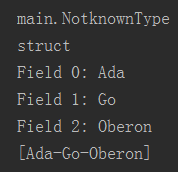go 反射
go 反射
反射:可以在运行时动态获取变量的相关信息
import (“reflect”)
- reflect.TypeOf,获取变量的类型,返回reflect.Type类型
- reflect.ValueOf,获取变量的值,返回reflect.Value类型
- reflect.Value.Kind,获取变量的类别,返回一个常量
- reflect.Value.Interface(),转换成interface{}类型

package main
import (
"fmt"
"reflect"
)
type Student struct {
Name string
Age int
Score float32
}
func test(b interface{}) {
t := reflect.TypeOf(b)
fmt.Println(t)
v := reflect.ValueOf(b)
k := v.Kind()
fmt.Println(k)
iv := v.Interface()
stu, ok := iv.(Student)
if ok {
fmt.Printf("%v %T\n", stu, stu)
}
}
func testInt(b interface{}) {
val := reflect.ValueOf(b)
val.Elem().SetInt(100)
c := val.Elem().Int()
fmt.Printf("get value interface{} %d\n", c)
fmt.Printf("string val:%d\n", val.Elem().Int())
}
func main() {
var a Student = Student{
Name: "stu01",
Age: 18,
Score: 92,
}
test(a)
var b int = 1
b = 200
testInt(&b)
fmt.Println(b)
}

获取变量的值
- reflect.ValueOf(x).Float()
- reflect.ValueOf(x).Int()
- reflect.ValueOf(x).String()
- reflect.ValueOf(x).Bool()
改变变量的值
- reflect.Value.SetXX相关方法
- reflect.Value.SetFloat(),设置浮点数
- reflect.Value.SetInt(),设置整数
- reflect.Value.SetString(),设置字符串
用反射操作结构体
- reflect.Value.NumField()获取结构体中字段的个数
- reflect.Value.Method(n).Call来调用结构体中的方法
package main
import (
"fmt"
"reflect"
)
type NotknownType struct {
s1 string
s2 string
s3 string
}
func (n NotknownType) String() string {
return n.s1 + "-" + n.s2 + "-" + n.s3
}
var secret interface{} = NotknownType{"Ada", "Go", "Oberon"}
func main() {
value := reflect.ValueOf(secret) // <main.NotknownType Value>
typ := reflect.TypeOf(secret) // main.NotknownType
fmt.Println(typ)
knd := value.Kind() // struct
fmt.Println(knd)
for i := 0; i < value.NumField(); i++ {
fmt.Printf("Field %d: %v\n", i, value.Field(i))
//value.Field(i).SetString("C#")
}
results := value.Method(0).Call(nil)
fmt.Println(results) // [Ada - Go - Oberon]
}




